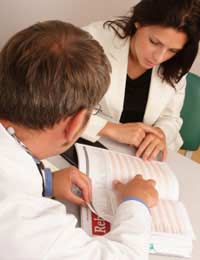Endometritis

Endometritis is the medical term used to describe an inflammation of the inner lining of the uterus. This inner lining or endometrium, can become inflamed in the presence of infection or as a symptom of another condition. Depending on the exact cause of the inflammation and the duration of the condition the inflammation is classified into one of two catagories: acute endometritis or chronic endometritis.
Chronic Endometritis
Certain diseases such as chlamydeous, pelvic inflammatory disease, or tuberculosis cause chronic endometritis. Chronic endometritis is characterised by the variable number of plasma cells that can be found in the endometrial stroma or lining. In some cases of chronic endometritis such underlying conditions as cancer can also increase the severity and symptoms of the disease.Acute Endometritis
Acute endometritis is short-term inflammation of the endometrium caused by infection. Infections can begin in the area through the use of non-sterile medical instruments, complications during abortion, compromised child birth, repeated pelvic exams, and through residual fragments of placenta being left in the uterus after abortion or childbirth.Symptoms of Endometritis
Although the causes of endometritis can differ the symptoms are almost always the same. Common symptoms of endometritis include pain or cramping in the lower abdomen, abnormal vaginal bleeding, abnormal vaginal discharge, increased vaginal discharge that is abnormal in quantity, colour, consistency, or smell, high fever, constipation, and pain during bowel movements. Symptoms of chronic endometritis can also include severe pain with menstruation, heavy bleeding, and nausea.When the above symptoms are presented to a doctor for diagnosis he or she will run several tests to confirm or rule out endometritis. The most common tests performed are blood tests such as a WBC (white blood count) which checks for the presence of infection and ESR (sed rate), endocervical cultures from vaginal swipes or scrapes, which help diagnose chlamydeous and other infections, endometrial biopsies to identify abnormal cell structure, and laparoscopy to remove infected tissue for further study. Once endometritis has been confirmed proper treatment can be prescribed.
Treatment of Endometritis
The most common treatment for endometritis is the prescribing of antibiotics. For less severe cases or in the case of chronic endometritis these antibiotics can be taken at home until the condition improves or clears. Also, some doctors and patients have seen improvements in the symptoms of chronic endometritis with the regular use of oral contraceptives (birth control pills). In acute cases the antibiotics may need to be administered intravenously and the patient would have to be hospitalised. In this instance the intravenous antibiotics are usually followed with or used in combination with oral antibiotics as well.During treatment for endometritis it is important that the patient get plenty of rest, that they remain well hydrated, and that they use a condom when engaging in sexual activity. In some cases the partner of an infected person will also need to treatment with a course of antibiotics. If treatment with antibiotics is unsuccessful the condition can become more serious. Untreated endometritis or resistant endometritis can lead to septic shock, infertility, and the formation of uterine abscesses.
- How Your Job Can Hurt Your Tummy
- Antibiotics and Your Tummy
- Diagnosing Abdominal Illness
- MMR Vaccine Scandal and Bowel Problems
- Reduce Your Alcohol Intake
- Prescription Medication and Your Stomach
- Stress and Your Digestive System
- Intestinal Parasites
- All You Need To Know About Constipation
- Leaky Gut Syndrome
- Tumours in the Stomach
- Ovarian Cancer
- Pancreatitis
- Peritonitis
- Polycistic Ovaries
- Stomach Cancer
- Diverticulitis
- Flatulence
- Food Allergies
- Gall Stones
- Menstrual Cramps
- Hernias
- Infections and Bugs
- Gastroenteritis
- Acid Reflux Disease
- Appendicitis
- Bowel Cancer
- Colitis
- Crohn's Disease
- Digestive Disorders
- What are Peptic Ulcers?
- What is Gastroenteritis?
- What is Irritable Bowel Syndrome?


Re: Symptoms of Stomach Migraines
When I started menopause 8yesrs ago I had my first stomach attack. With me I start to sweat profusely then comes the pain so…
Re: How Cauda Equina Syndrome Affects the Stomach
I have had cauda equina syndrome now for 10 years. For a considerable amount of that time I took…
Re: Symptoms Of Peptic Ulcers
I also have this chest pain and my heart is beating very fast and painfull and the other thing is that my left side breast it pains.i…
Re: Symptoms Of Peptic Ulcers
I was diagnosed of gastric ulcer after I went for an endoscopy. I have used intravenous rabeprazole and now am using ulsakit. But I…
Re: Symptoms Of Peptic Ulcers
Hello guys, first all of you have to visit gi. And done ugd, then only Dr have to came to know what happened inside your stomach. Yes…
Re: What is Thickening of the Bowel?
I had a virtual colonoscopy and was told I had a thickened left colon. I have acute bouts of lower left abdominal pain which…
Re: What is Thickening of the Bowel?
HI CAN SOME BODY TELL ME WHAT MILD SMALL BOWEL VERSUS IN THICENING RELATED TO UNDERDISTENTION MEAN?
Re: Symptoms Of Peptic Ulcers
Princess gold - Your Question:I av ulcer and I feel tiredness, dizzy, pain under my left breast ? Is it still a sign of ulcer ?
Re: Symptoms Of Peptic Ulcers
I av ulcer and I feel tiredness, dizzy, pain under my left breast ? Is it still a sign of ulcer ?
Re: Symptoms Of Peptic Ulcers
ola - Your Question:I have chest pain in my left chest ,sometimes I have pain under the armpit. am just fiftten years of age.I do HV…